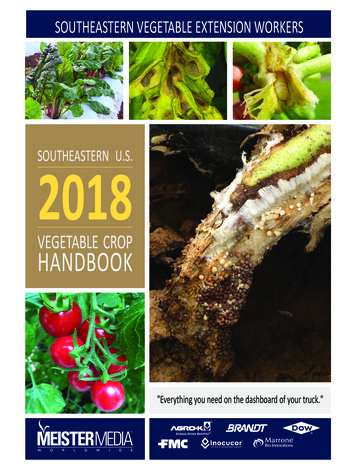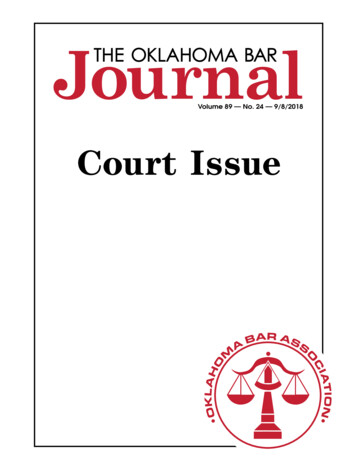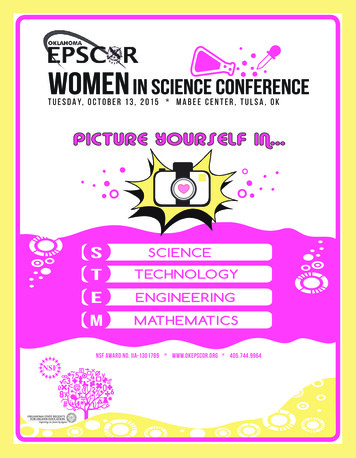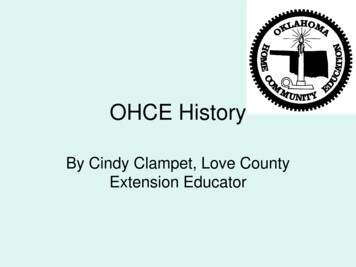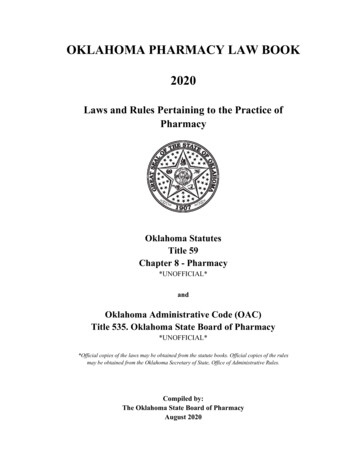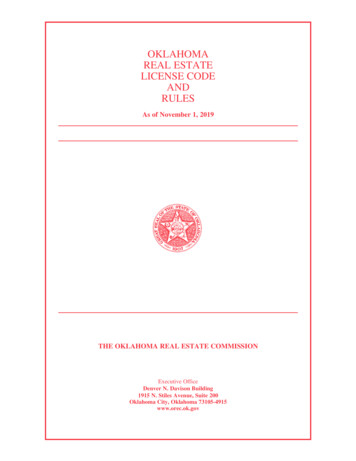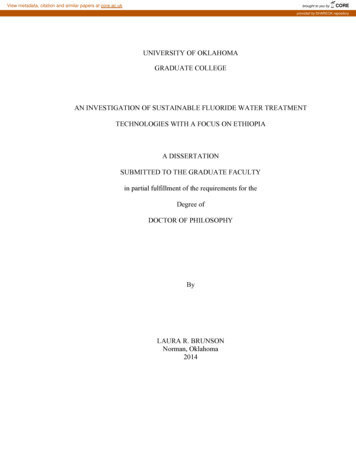
Transcription
View metadata, citation and similar papers at core.ac.ukbrought to you byCOREprovided by SHAREOK repositoryUNIVERSITY OF OKLAHOMAGRADUATE COLLEGEAN INVESTIGATION OF SUSTAINABLE FLUORIDE WATER TREATMENTTECHNOLOGIES WITH A FOCUS ON ETHIOPIAA DISSERTATIONSUBMITTED TO THE GRADUATE FACULTYin partial fulfillment of the requirements for theDegree ofDOCTOR OF PHILOSOPHYByLAURA R. BRUNSONNorman, Oklahoma2014
AN INVESTIGATION OF SUSTAINABLE FLUORIDE WATER TREATMENTTECHNOLOGIES WITH A FOCUS ON ETHIOPIAA DISSERTATION APPROVED FOR THESCHOOL OF CIVIL ENGINEERING AND ENVIRONMENTAL SCIENCEBYDr. David A. Sabatini, ChairDr. Lowell BusenitzDr. Elizabeth C. ButlerDr. Robert C. KnoxDr. Robert Nairn
Copyright by LAURA R. BRUNSON 2014All Rights Reserved.
This dissertation is dedicated to the women and children around the world that spendcountless hours each day walking to collect water for their families.
AcknowledgementsNone of this work would have been possible without the advice, support,encouragement, teaching, and mentoring of Dr. David Sabatini. Dr. Sabatini has servedas my graduate adviser for over eight years. He encouraged me to come to OU for mygraduate work and to pursue graduate degrees in Environmental Science even though Idid not come from a science or engineering background. From Dr. Sabatini, I havelearned technical aspects about engineering and science, as well as writing, leadership,and how to be a better human being. I will utilize the lessons I have learned from Dr.Sabatini throughout the rest of my life.I would also like to thank Mrs. Frances Sabatini who has been a constant cheerleaderthroughout my graduate school experience. Thanks to Peggy Sabatini, who has been agraduate assistant in the lab for many years, and after our travels to Ethiopia, is like alittle sister to me.Peggy and Frances have both provided countless laughs andencouragement.Thank you to the additional committee members for this dissertation – Dr. ElizabethButler, Dr. Lowell Busenitz, Dr. Robert Knox, and Dr. Robert Nairn. These fourfaculty members have spent hours teaching me, both in their classes and throughadditional questions and paper reviews. I thank them for their time and guidancetowards making the research stronger and making this a better dissertation.I thank Dr. Andy Madden who trusted me to spend many hours in his lab using severalpieces of characterization and measurement equipment. I thank him for his timeteaching me how to use them. Thanks to Dr. Nairn and Dr. Zaman for the use of theirmicrowave digestion equipment and high temperature oven, respectively.I am very grateful for funding from the following sources: the Sun Oil CompanyEndowed Chair, the National Science Foundation Graduate Fellowship Program, theiv
Environmental Projection Agency Science To Achieve Results Fellowship Program, theOU WaTER Center, the Graduate College at the University of Oklahoma, and theCollege of Engineering at the University of Oklahoma.I appreciate the helpful and generous assistance with funding paperwork, enrollment,logistics and much more from Molly Smith, Brenda Clouse, Susan Williams and AudreCarter in the College of Engineering.The work done in rural Ethiopia could not have been done without the generous help ofCatholic Relief Services Ethiopia, the Meki Catholic Secretariat, the Oromo Self HelpOrganization, CARE Ethiopia, Dr. Feleke Zewge, Teshome Lemma, Esayas Samual,Bekele Abaire, and most of all, Meseret Desalegn who was with us every step of theway during the several months of continuous flow column studies.Many thanks to the undergraduate lab assistants who went above and beyond providinghelp with lab work which included endless washing of glassware and batch test bottles.I thank them also for their friendship and entertainment. Over the years my wonderfullab assistants were Peggy Sabatini, Tessa Blanchard, Erik Tichansky, Aislinn McLeod,Katie Heitman, and Peter Everest.I am so appreciative of the support and encouragement and teaching that came from labmates over the years. I learned so much from all of them in various ways aboutresearch and writing, lab equipment, and how to do posters and research presentations.Thanks to “Oat” Witthayapanyanon, Tri Pham, Linh Do, “Mink” Attaphong, ChrisCope, Hayley Ryckman, Damon Webster, Teshome Lemma, Junyi Du, Sezin Kadioglu,Anisha Nijhawan and others that came to visit for a short time, for the learning, fun andfriendship-building times in the lab.In great part, this PhD was made possible by the friends and family who prayed for methrough presentations, papers, exams, and the final defense. I would like to specificallythank Virginia Tackett and Elda Shafer who were grandmas that weren’t here to see thisv
dissertation come to a conclusion, but who provided numerous prayers during the yearswhen they were still here. To my “Carla Mom”, Carla Walker who provides suchthoughtful support, I thank you.It is impossible to adequately thank the many friends and family that were with methroughout some or all of my graduate work. These loved ones provided laughs andfun, put up with my erratic schedule and lack of socializing, invited me for homecooked meals, shared their homes and sometimes their kids (“Auntee Laura’s kids”),made me take research breaks, commiserated during failures or frustrations, celebratedsuccesses, encouraged me, shared their lives with me and overall were there for me dayand in day out for years. I am deeply grateful for the love, support and friendship ofthis wonderful group of people and I am lucky to have them in my life.vi
Table of ContentsPageACKNOWLEDGEMENTS.ivTABLE OF CONTENTS viiLIST OF TABLES .xLIST OF FIGURES .xiiABSTRACT .xviCHAPTER 1 Introduction . 1Safe Drinking Water and Fluoride 1Fluoride Removal Technologies 2Goal and Objectives .7Overview of Chapters 8References .10CHAPTER 2 In Pursuit of Sustainable Water Solutions in Emerging Regions 16Abstract .16Introduction .16Implementation Challenges .17Sustainable Development 21Social and Cultural Assessment .23Market-based Implementation .26Technology Development .31Sustainability Tools .32Practical Implications .33vii
Conclusion .34Acknowledgements .35References .35CHAPTER 3 The Role of Surface Area and Surface Chemistry during anInvestigation of Eucalyptus Wood Char for Fluoride Adsorption fromDrinking Water 43Abstract 43Background .44Materials and Methods 49Results and Discussion 52Conclusion .64Acknowledgements .65References .66CHAPTER 4 Practical Considerations, Column Studies and Natural OrganicMaterial Competition for Fluoride Removal with Bone Char and AluminumAmended Materials in the Main Ethiopian Rift Valley. . 72Abstract 72Introduction .73Methods .78Results and Discussion 81Conclusion .95Acknowledgements .96References .96viii
CHAPTER 5 Methods for Optimizing Activated Materials for Fluoride Removalfrom Drinking Water Sources .104Abstract .104Introduction. 105Materials and Methods .110Results and Discussion .114Conclusion .135Acknowledgements .136References .137CHAPTER 6Conclusions. .142APPENDICESAppendix A: Fluoride Removal by Bone and Wood Chars .149Appendix B: Competing Ions 151Appendix C: Iron Oxide Amendments .152ix
List of TablesPage2.1Examples of water projects in developing countries and possibleimprovements that could increase sustainability. Text in grey indicatesprojects with a high level of success .19-202.2Tasks that fall into each component of synergistic research ortreatmentimplementations .233.1Freundlich constants calculated from batch tests investigating fluorideremoval of aluminum amended and unamended wood and bone chars .543.2Specific surface area and pHPZC of aluminum amended, reducing agentmodified and unamended eucalyptus wood and bone chars at variouscharring temperatures . 563.3Freundlich constants calculated from batch tests investigating fluorideremoval of bone and wood chars modified with reducing agents andamended with aluminum or unamended. In all cases 1/n values have beenforced to a common values so Kf constants can be statistically compared .614.1Qe data for six media evaluated in batch isotherm studies .824.2Qe in mg of fluoride removed per gram of material calculated based on theamount of fluoride removed during the continuous flow column study runto saturation (Ceffluent Cinfluent). The bed volumes to Ceff 1.5 mg/Lobtained using the data presented in 4.1. Using the Langmuir equationboth the Langmuir Qm and the Qe value at 8.6 equilibrium fluorideconcentration are presented .86x
4.3Results of batch isotherms studying fluoride removal with and withoutthe presence of sulfate and natural organic material in solution .935.1Freundlich and Langmuir Constants and Qe1.5 data obtained usingbatch isotherm data for wood char alone and metal oxide amendedwood char .1165.2Freundlich and Langmuir Constants obtained using batch isothermdata for untreated, amended and pretreated wood chars .1195.3Metal loading, specific surface area and surface chemistry characteristicsof all materials tested .124C-1: Results of preliminary iron oxide amendment tests conducted on wood char withvariations in amendment time, concentration and method . . 152xi
List of FiguresPage2.1Diagram showing the three discussed areas crucial to successfulimplementation, their overlap where a sustainable outcome should beobtained, and their embedding in a broader systems perspective (theenabling environment) .223.1The equilibrium fluoride concentration, Ce, in mg/L (x-axis) versus mgof fluoride removed per gram of material, Qe, (y-axis) for both aluminumamended and unamended eucalyptus wood chars .553.2Bar graph shows specific surface area (m2/g) (left y-axis) and line graphshows the pHPZC (right y-axis) while charring temperature for bothaluminum amended and unamended eucalyptus wood chars is shownon the x-axis. .574.1Results of continuous flow columns studies where the x-axis shows bedvolumes and the y-axis shows effluent fluoride concentrations in mg/L.4.1A. Lab studies where the influent pH (unadjusted) was approximately 6.0 andthe solution was fluoride in deionized water. 4.1B. Field studies using nativegroundwater with an influent pH of approximately 8.2 . 83-844.2Graph shows results of continuous flow columns studies where the x-axisshows bed volumes and the Y axis shows effluent fluoride concentration inmg/L. Influent fluoride concentration was 8.6 mg/L and pH and competingions vary as stated in the key .894.3Graph shows results of rapid small scale column tests where the x-axisshows bed volumes and the y-axis shows effluent fluoride concentrationxii
in mg/L. Columns have volumes of 34.9 and 7.9 cm3 and average particlesizes of 637 and 302 µm , for large and small scale respectively. Startingconcentration and flow rate were equivalent for both at 8.6 mg/L fluorideand 1.2 ml/min 945.1Results of batch isotherms showing the fluoride removal capacities ofuntreated wood char and metal oxide amended wood chars. Qe, the mg offluoride removed per gram of media is plotted against Ce, the equilibriumconcentration of fluoride in mg/L .1155.2Results of batch isotherms showing the fluoride removal capacities ofuntreated wood char and metal oxide amended wood chars with andwithout pretreatment (KM potassium permanganate, HP hydrogenperoxide). Figure 5.2A shows results of wood char treated with aluminumsulfate and Figure 5.2B shows results of wood char treated with iron (III)chloride. Qe, the mg of fluoride removed per gram of media is plottedagainst Ce, the equilibrium concentration of fluoride in mg/L .117-1185.3Results of material analysis where 5.3A shows metal loading percentages,5.3B shows point of zero charge values and 5.3C shows specific surfacearea data. Numbers above the bars in each graph note the Qe1.5 values forthat media . 122-1235.4Data shows the fluoride removal capacities of untreated wood char andmetal oxide amended wood chars (WC), with and without pretreatment,(KM potassium permanganate, HP hydrogen peroxide) normalized bymetal content. 5.4A shows results of wood char treated with aluminumxiii
sulfate, 5.4B shows wood char treated with aluminum chloride, 5.4Cshows wood char treated with iron (III) nitrate with the inset graph showingthe data only up to Ce 5 and 5.4D shows wood char treated withiron (II) chloride. The y-axis shows, Qe/metal %, the mg of fluoride removedper gram of media normalized by metal content, and is plotted against Ce,the equilibrium concentration of fluoride in mg/L . .127-1295.5Results of batch isotherms showing the fluoride removal capacities ofuntreated wood char and metal oxide amended wood chars normalized byboth specific surface area and metal content. Qe, the mg of fluorideremoved per gram of media is normalized by specific surface areaand metals content (mg fluoride * g char/g metal * m2) and plottedagainst Ce, the equilibrium concentration of fluoride in mg/L .134A-1Graph shows adsorption isotherms of fluoride removal by Ximeniaamericana (XA) and Eucalyptus robusta (EU) wood chars amendedwith aluminum oxides, plotting fluoride levels adsorbed by the chars(Qe, mg fluoride/g wood char) versus equilibrated aqueousfluoride concentration (Ce, mg/L) . 149A-2Graph shows adsorption isotherms of fluoride removal by fish andbone chars and aluminum oxide amended fish and bone chars, plottingfluoride levels adsorbed by the chars (Qe, mg fluoride/g wood char)versus equilibrated aqueous fluoride concentration (Ce, mg/L) .150B-1Adsorption isotherms of fluoride on fish bone char (FBC), withcompeting ions sulfate (SO4) and phosphate (PO4) present in somexiv
systems as noted in the legend. The y-axis shows fluoride levelsadsorbed by the fish bone char (Qe, mg fluoride/g fish bone char) andthe x-axis shows equilibrated aqueous fluoride concentration (Ce, mg/L) .151.xv
AbstractHuman consumption of unsafe drinking water from an unimproved source is aglobal issue affecting approximately 748 million people worldwide. While this numberhas been decreasing in recent years, an additional 1.2 billion people are estimated tolack access to water that is consistently free from health risks. This dissertation beginswith a literature review investigating drinking water improvement initiatives around theworld and a discussion of reasons why these initiatives often fail. Resources areprovided for researchers and practitioners working on drinking water treatmentimplementations and examples of implementations that have failed or succeeded arediscussed. The conclusion from this review is that global drinking water solutions willbe more effective when designed and implemented by personnel from multipledisciplines.For example, people in several fields, including: social sciences,engineering and business, should collaborate and share ideas and expertise. Ideally thiscollaboration should start at the genesis of a project and continue throughimplementation and follow up.There is hope that the synergistic efforts ofmultidisciplinary teams will help to increase the number of successful water initiatives.Next the dissertation focuses on the problem of elevated fluoride concentrationsin drinking water. Naturally occurring fluoride is the second largest issue contributingto the global water crisis. It is estimated that globally over 200 million people areaffected by elevated concentrations of fluoride in drinking water. The goal of thetechnical portion of this dissertation is to investigate locally available and sustainablematerials that can be used to remove fluoride from drinking water, with a focus onEthiopia and eastern Sub-Saharan Africa. Bone char is very effective as an adsorptivexvi
material, but is not always accepted by communities due to religious or cultural beliefs.Therefore, this research evaluated methods to improve the fluoride removal capacity ofbone char as well as investigated materials that might serve as a replacement for bonechar in appropriate communities. Eucalyptus trees are prevalent in Ethiopia where alarge fluoride problem exists, and thus, eucalyptus wood char was investigated as apotential substitute for bone char. This dissertation studied wood char produced fromEucalyptus robusta as an adsorption material to remove fluoride from water, therebymaking it safe for consumption. Although the use of eucalyptus wood char aloneremoved minimal fluoride, when it was amended with aluminum and iron oxides itevidenced much higher fluoride removal capacities. Metal oxides, produced fromstarting materials such as aluminum sulfate and iron (III) nitrate, were used to amendthe wood char. Metal amendments resulted in fluoride removal capacities ranging from3 to 50 times higher than wood char without amendment. The combination of woodchar and metal oxide amendment is synergistic because the wood char provides a matrixwith a high specific surface area for the metal oxides to adhere to while the metal oxideamendment increases the electrostatic attraction of the char surface for fluoride.Additionally, wood char was pretreated with oxidizing agents such as hydrogenperoxide and potassium permanganate prior to metal amendment. These pretreated andmetal amended chars were found, in most cases, to have increased metal loading ratesand, in some cases, higher fluoride removal capacities.This dissertation also looked at ways to improve the adsorption effectiveness ofbone char for communities where bone char is an acceptable material for drinking watertreatment. Amending bone char with aluminum nitrate showed an increase in fluoridexvii
removal at high equilibrium concentrations but not at low equilibrium concentrationsclose to the WHO recommended value for fluoride (1.5 mg/L). Select fluoride removalmaterials, including aluminum impregnated wood char, activated alumina, bone charand aluminum amended bone char, were studied in the field using groundwater from awell in a rural Ethiopian community. Field results suggested that the combination ofelevated groundwater pH along with competing ions such as sulfate (both common inground waters of the Ethiopian Rift Valley) affected the fluoride removal capacities ofthe materials studied, particularly the aluminum impregnated wood char. Finally, thisresearch tested the validity of the Rapid Small Scale Column Tests (RSSCT) principlesfor bone char adsorbing fluoride from water. These experiments indicated that RSSCTprinciples are applicable for bone char; use of this approach can result in large time andcost savings to researchers and implementers. Overall, this dissertation provides severalconclusions that are practically helpful to researchers in the field and also foundationalresearch on which future studies can build to continue efforts to find sustainable andappropriate fluoride removal technologies.xviii
CHAPTER 1IntroductionSafe Drinking Water and FluorideLack of safe drinking water is a key global issue. The World HealthOrganization (WHO) and the United Nations International Children’s Emergency Fund(UNICEF) estimate that 748 million people currently lack access to an improved watersource (WHO and UNICEF, 2014). Onda et al. (2012) suggested that in addition to the748 million people without an improved water source, another 1.2 billion people maybe consuming water from sources that are improved but still at risk for microbialcontamination. Lack of safe water is further exacerbated by the reality that 1.4 billionpeople are estimated to live on less than 1.25 (US) per day (Chen and Ravallion,2008). In addition, water-related health issues contribute to concerns such as lack ofeducation, gender equity and economic development. To mitigate these drinking waterissues, sustainable, inexpensive and locally available water treatment technologies mustbe developed, improved and implemented.After pathogens, the largest issue contributing to lack of safe drinking water isnaturally occurring fluoride, which is estimated to affect 200 million people globally(Amini et al., 2008). The WHO recommended fluoride limit in drinking water is 1.5mg/L (World Health Organization, 2011). Fluoride is naturally occurring in thegroundwater of many areas of the world including: the Rift Valley of Africa, portions ofChina and India and parts of the southwestern United States (Brindha et al., 2010;Fewtrell et al., 2006; Meenakshi and Maheshwari, 2006; Nigussie et al., 2007).1
Although fluoride is naturally occurring in groundwater, it can also occur due toanthropogenic processes such as aluminum smelting and fertilizer production (Hem,1985; Hudak, 2008). Fluoride is an example of an element where the dose consumeddetermines whether it is beneficial or toxic. In low doses fluoride helps to preventdental carries and, thus, improves the health of teeth (Fawell et al., 2006; Schamschulaand Barmes, 1981). However, consumption of higher concentrations can be harmful asit causes dental and skeletal fluorosis (Fawell et al., 2006; Gazzano et al., 2010). Dentalfluorosis results in darkening or mottling of teeth, which, while not physicallydebilitating, can cause social and financial issues due to the stigma of mottled teeth.Skeletal fluorosis can cause bones to become deformed or stiff which can limit mobilityand/or cause pain (Kaseva, 2006; Meenakshi and Maheshwari, 2006). Therefore, manyresearchers are investigating fluoride removal technologies (Abe et al., 2004; Ayoob etal., 2008; Gwala et al., 2011; Nigussie et al., 2007).Fluoride Removal TechnologiesWater treatment methods frequently investigated for fluoride removal include:precipitation, ion exchange, electrocoagulation, and adsorption (Brunson and Sabatini,2009; Gwala et al., 2011; Kamble et al., 2007; Meenakshi and Maheshwari, 2006; Rao,2003; Tchomgui-Kamga et al., 2010). For rural regions in developing countries,techniques should be inexpensive, sustainable and use locally available materials fortreating water containing high concentrations of fluoride. The Nalgonda techniqueutilizes alum and lime to produce aluminum oxide precipitates that sorb and settlefluoride ions. This technique is popular because of its low cost and use of chemicals that2
are easily obtained. However, the Nalgonda technique requires frequent addition ofchemicals, produces copious amounts of waste sludge, and is not efficient for fluorideremoval when the starting concentration is high (Fawell et al., 2006; Nigussie et al.,2007). While electrocoagulation can effectively remove fluoride, it requires some formof electricity (Gwala et al., 2011). Activated alumina is an adsorptive materialfrequently used in filtration systems. Adsorption can be helpful for fluoride removalbecause it operates using gravity flow, and, depending on the sorptive material, can beeffective at treating water to meet the WHO fluoride standard. Activated alumina can beeffective, but is a manufactured material that may be prohibitively expensive to obtainin rural developing regions. Therefore, research evaluating less expensive and locallyavailable adsorptive materials is desirable in an effort to respond to the limitations oftechniques discussed above.Bone char has been widely investigated as an adsorptive material for removal offluoride and several trace metals (Bhargava and Killedar, 1991; Kaseva, 2006; Larsen etal., 1994; Thomson et al., 2003). Bone char is primarily composed of hydroxyapatite(70-76%) and carbon (8-11%) and is currently produced in several developing countriesfrom waste bones, which makes it relatively inexpensive (Medellin-Castillo et al., 2007;Müller, 2007; Purevsuren et al., 2004; Wilson et al., 2003). Charring animal bonesremoves organic matter from the bone structure, producing a large specific surface areawhich is helpful for high adsorption capacity (Chidambaram et al., 2004; Kaseva,2006). For example, Medellin-Castillo et al. (2007) reported a specific surface area of104 m2/g for their tested bone char. This is similar to levels reported by others, such as150 m2/g (Chen et al., 2008) and 105 m2/g (Brunson and Sabatini, 2009). Variations in3
specific surface area can be attributed to char source, type of bones and preparationmethod. Bone char also exhibits favorable surface chemistry with Medellin-Castillo etal. (2007) and Brunson and Sabatini (2009) both finding the point of zero charge(pHPZC) of bone char to be close to 8.3. In solutions with pH values below the pHPZC, thebone char surface will exhibit a positive charge, while at solution pH values above thepHPZC the material will exhibit a negative charge. Thus, for fluoride removal occurringin groundwater with near neutral pH values, a material with a high pHPZC will evidencea positive surface charge which will attract negatively charged fluoride ions. Despite itsfavorable surface chemistry and effective fluoride removal, bone char is not accepted insome communities due to religious and cultural reasons or poor quality of charproduction (Fawell et al., 2006), leading to the need for alternate materials.New research investigating the potential for using a carbon-based material, suchas wood char, as an adsorption material is helpful for locations where bone char is notaccepted. Wood is typically composed of carbon (50%), oxygen (44%), hydrogen (6%)and trace amounts of metals (Pettersen, 1984; Rowe and Conner, 1979). However, thechemical composition and other characteristics of wood can vary based on location, soiltype, season, age and type of wood (Pettersen, 1984). The specific surface area of woodchar is shown to differ greatly depending on charring conditions, wood type andlocation of wood growth. For example, James et al. (2005) showed wide ranges ofspecific surface area for wood chars produced in laboratory conditions, ranging from1.0 to 397 m2/g, and different kinds of wood charred in nature, ranging from 1.7 to 85m2/g. Although wood char in some cases exhibits a high surface area, a study by Abe etal. (2004) showed that bone char has a much higher fluoride removal capacity than4
several tested wood chars. Therefore, methods are needed to improve the fluorideremoval capacity of wood chars.Metal amendments have shown promise as one way to improve the fluorideremoval capacity of wood chars. For example, studies have shown promising results forremoving fluoride with aluminum or iron-based precipitates.Levya-Ramos et al.(1999) found that impregnating activated carbon with aluminum greatly improved thefluoride removal capacity. A material produced from aluminum and iron was studiedby Biswas et al. (2007) and results showed a maximum removal value of 18 mg offluoride removed per g of material as calculated by the Langmuir equation. The successof fluoride adsorption by metal amendments is attributed to the attraction between thenegatively charged fluoride ions and the positively charged metal oxide surfaces,resulting in ion exchange between fluoride and hydroxide ions on the material surface.While bone char has previously shown a high fluoride removal capacity, it is notreaching the removal effectiveness of some of the aluminum/iron based materialsdiscussed above, which means it may be useful to investigate ways of enhancingfluoride uptake with bone char.A final approach of interest is pretreating charred media with either oxidizing orreducing agents to alter their surface chemistry. Pretreatment methods could beinvaluable for their effects on surface chemistry. Polovina et al. (1997) suggested this isone of the most important aspects of an adsorption material. There are several potentialeffects of pretreating char media. One is that pretreatment of media with reducingagents may remove some acidic functional groups from the surface of the materials,which would increase the basicity of the media and, thus, increase the pHPZC values.5
This change in pHPZC should increase the attraction between the media and fluoride ionswithout the requirement of metal amendments. Minimal work has been done in thisarea.One study was conducted where activated carbon was treated with ironammonium sulfate and sodium dithionite to enhance removal of hexavalent chromiumfrom water. While the study by Han et al. (2000) did not show success with increasedhexavalent chromium removal, their preliminary work laid the foundation for thecurrent research seeking to enhance fluoride removal. A se
Dr. David A. Sabatini, Chair . Susan Williams and Audre Carter in the College of Engineering. The work done in rural Ethiopia could not have been done without the generous help of . without pretreatment (KM potassium permanganate, HP hydrogen peroxide). Fig


